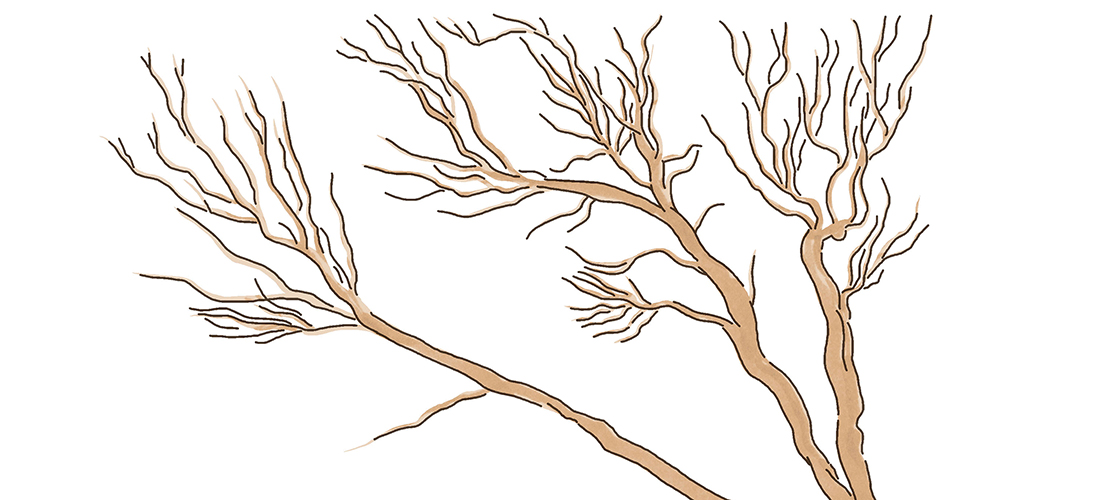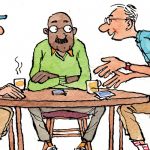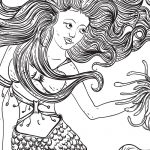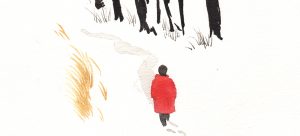
Saving George
An anchor of enchantment in the front yard
By Jim Dodson
His name is George. That’s what we’ve taken to calling him, at any rate. George is old and bent, weathered by age.
We think he might be pushing 100 years old.
I’ve known George most of my life. Grew up just two doors from down from where he lived but I never paid him much notice until recently.
That’s because George is an old tree, Crataegus phaenopyrum, we think, based purely by his leaf pattern and bark. His common name is a Washington hawthorn — hence the nickname we’ve bestowed on him.
But here’s where the sweet mystery deepens.
According to my tree identification book, Washington hawthorns are relatively small flowering trees — in some cases, shrubs — that produce early and abundant white flowers in the spring and vivid red berries that last into winter, a bounty for winter birds, especially cedar waxwings. They’re also reportedly poisonous to dogs, which could be a problem, since Ajax, our shameless golden retriever, will eat anything put before him. On the other hand, he’s one lazy brute, unlike his Greek namesake, and not much for climbing trees. So Ajax is probably safe.
We moved into the neighborhood just before Thanksgiving. On our first day in the Corry house, I stopped to admire George. He was magnificently arrayed with gold and crimson leaves, like Joseph and the Amazing Technicolor Dreamcoat. The neighborhood is famous for its old graceful hardwoods, many of them well over a century old. George is clearly one of the neighborhood patriarchs. That’s why I paused to admire him the afternoon we moved in, suddenly remembering him from my childhood, making a mental note to free him from the tangle of English ivy vines that had grown around him like something from a fairy tale.
In a year of small wonders, it seemed wonderfully providential that we were moving into the Corry house, 100 feet from where I grew up. The Corry boys were my pals growing up. Their parents, Al and Mama Merle, were my parents’ good friends. Big Al was one of Greensboro’s leading builders, and the house he built for his wife and four kids — a gorgeous wooden bungalow with flowing rooms, parquet floors and host of innovative design touches — was one of the first houses built in Starmount Forest after the war.
For more than a year, my wife, Wendy, and I had quietly scouted houses throughout Greensboro. Then one Sunday after I heard the Corry house was for sale, we went for a look. I didn’t let on that the Corry house was always my favorite in the neighborhood. But after she walked through it, on the drive home to the Sandhills, Wendy quietly announced, “I think that’s the house.
It just feels like us.”
The Corry kids, all four of them, were thrilled to hear their homeplace was being purchased by a Dodson.
Each quickly got in touch to offer their enthusiastic congratulations. The Corrys were the most self-sufficient clan I ever knew, natural builders and people full of life. Chris, the oldest boy, actually lived in a tepee with his bride as they built their own dream home west of Greensboro. The Corry boys hunted, fished and could build anything with their hands. They were also crazily musical, playing stringed instruments of every sort. In 1969, son Craig and I made the Greensboro Teenage Talent Show playing guitars and singing Bob Dylan’s “Don’t Think Twice.” We called ourselves Alfred and James.
Big Al informed us that Alfred and James needed something
“extra” to win. “You boys need a shtick to impress the judges,” he said.
I asked him why we needed a stick on stage.
Big Al laughed. He hailed from Buffalo, New York. “That’s a Yiddish word,” he explained. “It means a comic gimmick, something to make people laugh. First rule of vaudeville — always leave ’em laughing.”
He suggested that we add kazoos to the act. We thought that was the silliest thing we’d ever heard, but Mama Merle bought us a couple anyway.
The director of the show asked us to play a second song while the judges made up their minds. So we did an encore — with guitars and kazoos. The audience gave us a standing ovation. We wound up in third place. I still have the program. TV host Lee Kinard invited Alfred and James to come on his Good Morning Show at Christmas. We worked up a couple of Christmas carols and did the second one with kazoos. The shtick worked wonders.
Craig grew up to marry Marcy Madden, his first girlfriend from just down the block. He became a veterinarian. Britt, his little brother, was a musical prodigy who became a music teacher and recently signed on to direct the music for Horn in the West. Ginger, the oldest and only girl, became a lawyer.
Like his papa, Chris was a jack-of-all-trades, a born builder of almost anything. He now sports a full-grown gray beard and knows his late mama’s house better than anyone alive because he built much of it with his father and took care of the place until Merle passed away a year or so ago. His wife, Fenna, told me in an email that Mama Merle and Big Al would both be so happy that a Dodson kid had come home again to purchase their house. From faraway California, Ginger wrote that she hoped we would have many happy years living there.
Which brings me back to George.
A week after we got settled, we took ladders, handsaws and a hatchet and liberated George from those wretched English ivy vines. The job took two afternoons, but George looked considerably more at ease, maybe even grateful. My nephew came and helped me clean out the area around his base, where I’ll soon plant Spanish bluebells and English daffodils for the spring.
I also planted six young trees, three Japanese maples I’d raised from sprouts and a trio of river birches like the three I planted once in Maine.
They stood in front of the post and beam house I built on a forested hilltop surrounded by birch and hemlock. The beams were rough-sawn Northern fir, with pegged heartwood pine flooring salvaged from a 200-year-old New Hampshire barn. On cold but sunny winter days, whenever the sun streamlining through that house’s large south-facing windows warmed the beams, you could hear gentle sighs and faint cracking sounds as the wood relaxed, expanded, exhaled.
That peaceful sound told me something I guess I’ve always known. That wood — trees — are something more than just fellow living and breathing organisms.
They are enchanted.
Maybe this explains why one of my first memories of life is of sitting on a low limb in a sprawling live oak next to our house by Greenfield Lake, in Wilmington, waiting for my father to come home from the newspaper where he worked. I was forever climbing trees, much to my mother’s chagrin, and sometimes falling out of them. My dad liked to call me Mowgli, the orphaned boy from Kipling’s Jungle Book, one of the first books I ever read on my own.
Come to think of it, the books I loved early on all seemed to have extraordinary trees in them — Greek and Roman mythology, the Tarzan books, almost every fairy tale I ever read contained forests that were either forbidden or simply enchanted, home to magic creatures, wizards, evil queens and noble woodsmen.
And why not? Plato and the ancient Greeks believed souls resided in sacred groves of trees, and the Buddha found enlightenment sitting beneath a fig. The Egyptian Book of the Dead mentions groves of sycamores where the departed find eternal bliss, and the Bible speaks of a Tree of Knowledge that altered paradise. The Irish word “druid” derives simply from a Celtic word for oak, while in India to this day people seeking miracles hang family rags on trees to make shrines to the gods. My Baptist grandmother always insisted that the dogwood tree with its perfect white petals and crimson heart was a symbol for Christ’s resurrection, and showed me the old Appalachian story to prove it.
The Glastonbury thorn, holds English lore, is a hawthorn tree that is said to have sprouted miraculously from the staff of Joseph of Arimathea when he traveled to Britain after Jesus’ crucifixion. The hawthorn blooms at Christmas, and the queen is traditionally brought one of its blooms with her tea on Christmas morning. In broader English lore, wherever hawthorns and oaks reside together, kindly fairies supposedly live as well.
I do hope that much holds true even if, come springtime, the old tree I liberated turns out to be something quite different.
There’s an old saying that an optimist is someone who plants a tree he may never live long enough to sit under.
That’s probably true for the six young trees I planted around George.
But come spring, home at last, I plan to sit under George when those bluebells and daffodils bloom. OH
Contact editor Jim Dodson at jim@thepilot.com.





